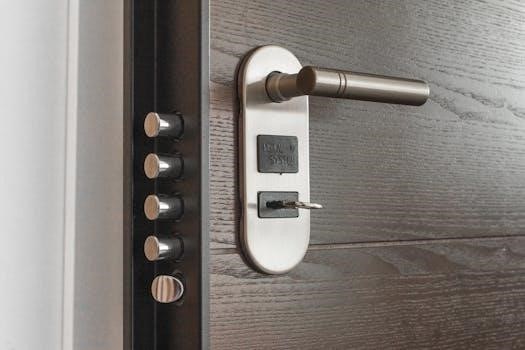
Allen Key Size Chart PDF⁚ An Overview
An Allen Key size chart PDF provides a readily accessible reference for identifying the correct hex key dimensions. These charts are invaluable tools ensuring proper fit, preventing damage, and simplifying fastener selection for various applications.

Understanding Allen Keys (Hex Keys)
Allen keys, also known as hex keys, are tools used to drive bolts and screws with hexagonal sockets. Understanding their purpose and common applications is crucial before diving into size charts and selection.
Definition and Purpose of Allen Keys
Allen keys, or hex keys, are L-shaped tools with a hexagonal cross-section, designed to tighten or loosen screws and bolts featuring a matching hexagonal socket. Their primary purpose is to provide a secure grip and apply torque to fasteners recessed within a component or assembly. The compact design and ease of use make them ideal for applications where space is limited or where a standard screwdriver cannot reach. They are crucial for preventing damage to the fastener and ensuring proper tightening.
Common Applications of Allen Keys
Allen keys find widespread use across numerous industries and everyday tasks. They are frequently employed in furniture assembly, bicycle maintenance, and automotive repair. You can find them in electronics for securing components, in machinery for adjusting settings, and in construction for fastening structural elements. Their ability to access recessed screws makes them essential for applications where conventional screwdrivers are impractical. The secure grip ensures proper torque application, making them ideal for securing fasteners in various mechanical assemblies.
Importance of Using the Correct Allen Key Size
Using the correct Allen key size is crucial to prevent damage to both the tool and the fastener. Proper fit ensures optimal torque transfer and avoids stripping or rounding.
Avoiding Damage to Screws and Bolts
Using the wrong size Allen key can lead to significant damage to screws and bolts. An undersized key may slip within the hexagonal socket, rounding the edges and making it impossible to tighten or loosen the fastener. Conversely, an oversized key simply won’t fit, potentially damaging the socket’s entrance. Either scenario can result in stripped screws or bolts, requiring replacement or specialized extraction methods. Therefore, always consult an Allen key size chart to ensure a precise fit, preserving the integrity of your fasteners and preventing costly repairs.
Ensuring Proper Fastening
Proper fastening relies heavily on using the correct Allen key size. When the right size Allen key is used, it provides full contact within the screw’s or bolt’s hexagonal socket. This complete engagement ensures optimal torque transfer, allowing for secure tightening without the risk of slippage. Insufficient engagement from an incorrectly sized key can lead to under-tightening, causing the fastener to loosen over time, or over-tightening, potentially stripping the threads. Therefore, consulting an Allen key size chart before fastening is crucial for achieving reliable and long-lasting connections in any assembly.

Allen Key Size Charts⁚ Imperial (SAE) vs. Metric
Allen keys are available in both Imperial (SAE) and Metric sizes, necessitating distinct size charts. Understanding the differences between these systems is crucial for selecting the appropriate key for a given fastener.
Imperial Allen Key Sizes and Dimensions
Imperial Allen key sizes, also known as SAE (Society of Automotive Engineers) sizes, are measured in fractions of an inch. Common sizes range from 0.028 inches to as large as 1 inch. A size chart specifies the width across the flats of the hexagonal key. These charts provide the decimal equivalent of the fractional inch size, aiding in accurate identification. Referencing an imperial Allen key size chart is crucial to ensure proper fit and prevent damage to the screw or bolt head. These charts are frequently included with self-assembly furniture.
Metric Allen Key Sizes and Dimensions
Metric Allen key sizes are measured in millimeters (mm). These keys are essential for fasteners designed using the metric system, offering a precise fit. Common metric sizes range from as small as 0.7 mm to 10 mm and beyond. Accurate dimensions are crucial for avoiding damage to the screw or bolt. Allen key size charts provide the exact measurements, ensuring proper engagement. These charts often correlate screw sizes with the appropriate Allen key size, simplifying the selection process. Metric Allen key dimensions are defined by standards like ISO 4762/DIN 912.
Allen Key Size Conversion Charts
Allen key size conversion charts are essential tools for translating between metric and imperial measurements. These charts help users quickly find equivalent sizes, ensuring compatibility when working with different fastener systems.
Converting Between Imperial and Metric Sizes
Converting between imperial (SAE) and metric Allen key sizes is crucial for various tasks. These conversions are necessary because fasteners are manufactured using both measurement systems. Using a conversion chart prevents damage to screws and bolts by ensuring the correct key size is selected. Charts typically list equivalent sizes side-by-side, allowing for quick and easy identification. These resources are invaluable for professionals and DIY enthusiasts who work with diverse hardware and need accurate size matches to avoid stripping or damaging fasteners, ensuring secure and proper fastening in all applications.

Finding and Using Allen Key Size Charts
Finding reliable Allen key size charts is essential for accurate tool selection. These charts are available online, in tool catalogs, and included with Allen key sets, aiding in identifying the correct key.
Where to Find Reliable Allen Key Size Charts
Reliable Allen key size charts can be found in several locations. Many tool manufacturers, like Truini, include charts with their Allen key sets. Online resources, such as Hand Tool Essentials, offer comprehensive conversion charts. Industrial supply websites and PDF documents adhering to standards like ASME B18.3 also provide accurate dimensions. Furniture assembly instructions sometimes include size charts, but dedicated tool sources are generally more detailed and comprehensive. Always verify the chart’s source and adherence to industry standards for accuracy.
How to Use a Size Chart to Identify the Correct Key
To use an Allen key size chart effectively, first, determine if you need an imperial (SAE) or metric key. Then, visually match the screw’s socket size to the chart’s diagrams. If possible, measure the socket’s width across the flats. Compare this measurement to the chart’s specifications to pinpoint the correct key size. Ensure a snug fit when inserting the key; looseness indicates an incorrect size. Using the right size prevents damage to both the tool and fastener.
Types of Allen Keys
Allen keys come in various forms, each designed for specific applications. Common types include long arm, short arm, and T-handle Allen keys, offering different levels of leverage and accessibility in diverse scenarios.
Long Arm vs. Short Arm Allen Keys
Long arm Allen keys provide extended reach and increased leverage, making them suitable for accessing recessed fasteners or applying greater torque. The longer arm offers better grip and reduces the force needed to tighten or loosen screws. Short arm Allen keys are more compact and ideal for tight spaces where maneuverability is limited. Their shorter length also makes them easier to carry and store in toolboxes or pockets, offering convenience for quick tasks in confined areas. Ultimately, the choice between long arm and short arm Allen keys depends on the specific application requirements and accessibility constraints.
T-Handle Allen Keys
T-handle Allen keys feature a perpendicular handle that provides a superior grip and enhanced torque. The T-shape design allows for increased leverage, making it easier to loosen stubborn screws or tighten fasteners securely. This design minimizes hand fatigue, especially during repetitive tasks or when dealing with high-torque applications. T-handle Allen keys are particularly useful in automotive repair, machinery maintenance, and other demanding jobs where precision and force are essential. Their ergonomic design offers improved control and efficiency compared to standard Allen keys, making them a valuable addition to any professional’s toolkit.

Allen Key Sets and Ranges
Allen key sets offer a comprehensive range of sizes, ensuring the right tool for every job. These sets are available in both metric and imperial measurements, catering to diverse needs.
Benefits of Owning a Complete Allen Key Set
Owning a complete Allen key set ensures you always have the correct size for any task, eliminating the risk of stripping screw heads or damaging equipment. A comprehensive set offers versatility, accommodating both small and large fasteners, and metric and imperial sizes. This eliminates frustration and saves time by avoiding trips to the hardware store for specific sizes. Furthermore, a well-organized set makes it easier to quickly locate the needed key, improving efficiency and overall project workflow, and is a good investment.
Popular Allen Key Set Manufacturers
Several reputable manufacturers offer high-quality Allen key sets catering to diverse needs. RS PRO provides comprehensive sets known for their durability and precision. Other popular brands include Truini, known for their wide range of hex key sets available for purchase, and those that adhere to ASME standards, ensuring dimensional accuracy and reliability. When choosing a set, consider factors like material quality (chrome vanadium steel is preferable), range of sizes, and storage options to ensure long-lasting performance and convenience for various applications and tasks.
Alternatives to Allen Keys
While Allen keys are purpose-built for hex sockets, a flat head screwdriver can work in a pinch. Ensure it fits snugly across the corners to avoid slippage and potential damage to the screw.
Using a Flat Head Screwdriver as a Substitute
In situations where an Allen key is unavailable, a flat head screwdriver might serve as a temporary substitute. This involves carefully selecting a screwdriver with a blade width that closely matches the internal dimensions of the hexagonal socket. The screwdriver should fit snugly across the opposite corners of the hexagon to provide adequate torque. However, this method is not ideal, as it increases the risk of damaging the screw or the tool due to the non-optimal contact and potential for slippage. It is crucial to exercise caution and apply even pressure to minimize these risks, and it is always preferable to use the correct Allen key size for optimal results and to avoid damaging the screw head.
Safety Considerations When Using Allen Keys
When using Allen keys, ensure proper engagement to avoid slippage and potential injury. Always apply even pressure and use appropriately sized keys to prevent damage to fasteners and tools.
Proper Usage Techniques
To ensure safety and effectiveness when using Allen keys, start by selecting the correct size for the fastener. Insert the key fully into the socket to maximize contact and prevent stripping. Apply consistent, even pressure while turning, avoiding excessive force that could damage the tool or the screw. For tight fasteners, consider using a longer Allen key for increased leverage. Maintain a straight alignment with the screw to prevent bending or breaking the key. Regularly inspect your Allen keys for wear or damage, replacing them as needed to maintain optimal performance and prevent accidents.
ASME B18.3 Standard for Allen Keys
The ASME B18.3 standard defines the specifications for Allen keys, ensuring dimensional accuracy and material quality. This standard is crucial for manufacturers and users seeking reliable and interchangeable tools.
Dimensions According to ASME B18.3 Standard
The ASME B18.3 standard provides precise dimensional specifications for Allen keys, including the width across flats, hexagon width across corners, and minimum bend radius. Adhering to these dimensions ensures interchangeability and proper fit within hexagonal sockets. The standard also outlines the acceptable tolerances for these dimensions, guaranteeing quality and performance. These specifications are vital for manufacturers aiming to produce Allen keys that meet industry requirements and for users seeking reliable tools. Consulting the ASME B18.3 standard ensures accurate measurements and proper tool selection for various applications requiring hexagonal socket fasteners.